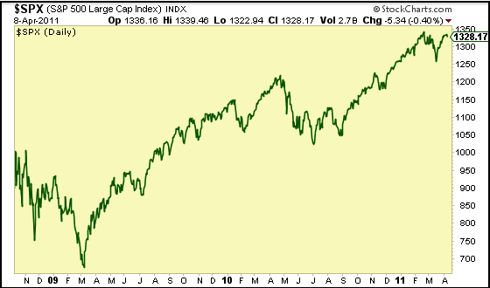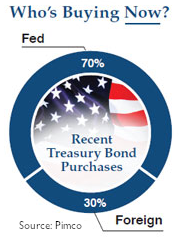And if you have wondered what QE is about, it is a program created by the US Federal Reserve to purchase US government bonds to finance US deficit. In doing so, the US government can offer a lower interest rate on the bonds put up for sale, because the Fed will step in to help purchase US government bonds not picked up by market buyers.
Without QE3, the US government would have to offer better and higher interest rates to buyers, and when that happens, the price of bonds will fall.
Update:
April 13, 2011 - 11:52AM: Goldman Sachs bearish on oil -
http://www.smh.com.au/business/markets/goldman-sachs-turns-bearish-on-oil-20110413-1dddf.html
Reference: http://seekingalpha.com/article/262856-qe3-will-come-when-markets-start-to-correct
QE3 Will Come When Markets Start to Correct
QE2 is supposed to end on June 2011. Will the Fed continue with QE3? In short, yes, but probably not right away.
Lately, Richard Fischer of the Dallas Fed has called upon Mr. Bernanke to end QE2 right away. Oil, precious metals and food prices are soaring. Overall, the pressure on Mr. Bernanke to end quantitive easing is growing. However, although the pressure is mounting on the Fed to end quantitive easing, this outcome is not likely. More likely is that the Fed will stop QE2 temporarily in order to test how the equity and bond markets will react. And if the markets will start to correct, he will probably resume QE.
There are a few reasons for that: First, QE1 ended at the first quarter of 2010. Not long after (as can be seen from the chart below) the S&P 500 peaked. The S&P 500 has declined by about 16%. At the end of August 2010, Mr. Bernanke hinted he will start QE2. This announcement pretty much marked the end of the correction. It’s interesting to note that the only time since the beginning of QE that the S&P 500 had a meaningful correction is when the Fed stopped QE1.
From the chart below, you can see there is a high correlation between the expansion of the Fed’s balance sheet and the rise of the S&P 500. (According to David Rosenberg, there is an 88% correlation). This leads to the adding up that the current rally can be mostly contributed to the excessive liquidity. As Marc Faber said "When money is being printed every thing will go up." Therefore, this leads to the conclusion that the Fed will have to continue to support the market in order to avoid a crash in the equity markets.
The second reason is mostly political. If the market will start to correct after QE2 is ended, two things will happen: (1) The political pressure on the Fed to resume quantitive easing in order to "save" the equity markets will grow; (2) As the market corrects, the Fed will have an excuse to continue with QE, after which it will be harder to blame the Fed for continuing QE for no reason.
Thirdly, the Fed is the biggest purchaser of Treasury Bonds. If the Fed will stop the purchases of Treasury Bonds, they’re risking an interest rate spike, which as a result will make mortgages less serviceable (which will put additional pressure on the housing market), and will make the U.S debt compound at an even faster rate.
Lastly, the only way the U.S. government can "solve" their debt problem is by inflating it away (outright default is unlikely because of political reasons). If the Fed will keep inflation high, and as a result devalue the USD, this then makes the debt more serviceable.
To sum up, the Fed has no other option but to continue with quantitive easing. However, that will probably not happen right away. After the markets will start to correct and interest rates rise, only then the Fed will probably announce the continuation of QE.
Disclosure: I am long gold and silver



